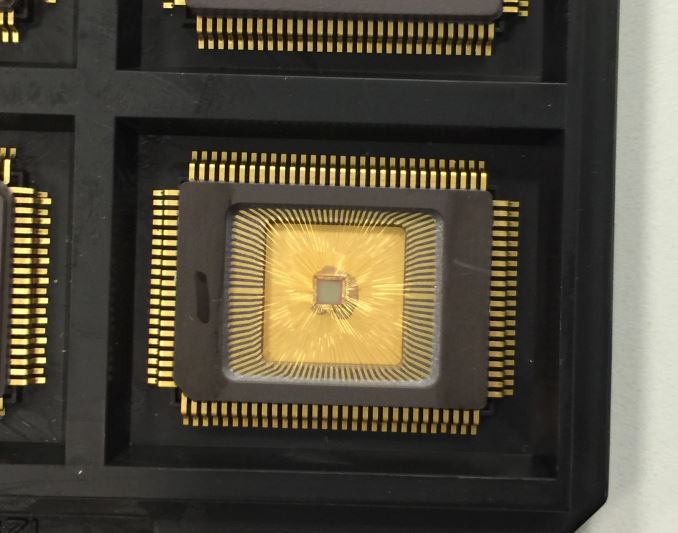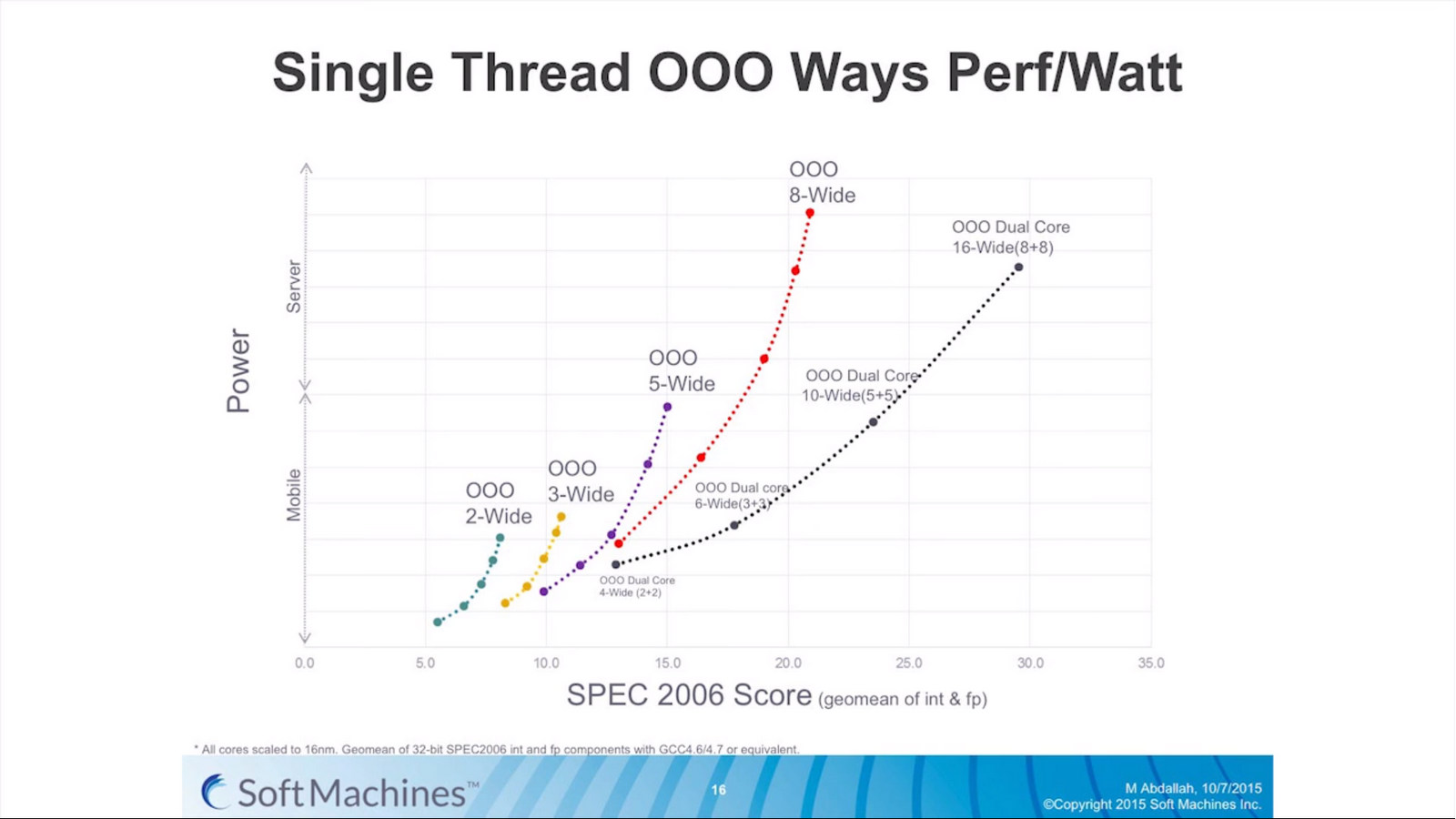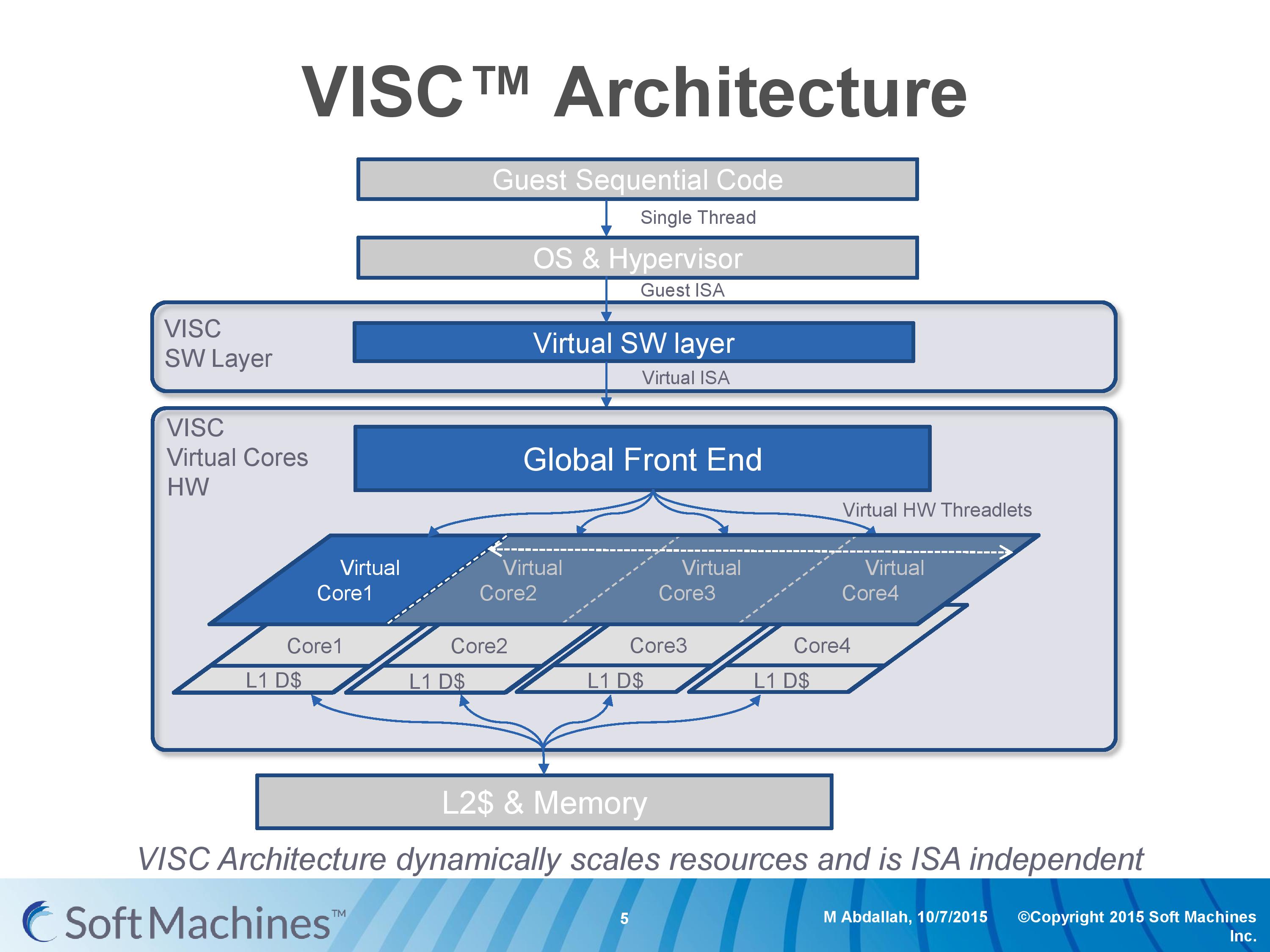Examining Soft Machines' Architecture: An Element of VISC to Improving IPC
by Ian Cutress on February 12, 2016 8:00 AM EST- Posted in
- CPUs
- Arm
- x86
- Architecture
- Soft Machines
- IPC

Last week, Soft Machines announced that their 'VISC' architecture was available for licensing, following the announcement of the original concepts over a year ago. VISC, in a nutshell, is designed as a solution to improving the number of instructions per clock a single thread can process in a given time, which potentially makes it a very interesting design in an era where IPC gains are harder and harder to realize.
The concepts behind their new ‘VISC’ architecture, which splits the workload of a single linear thread across multiple cores, are intriguing and exciting. But as with any new fundamental change in computer processing, subject to a large barrage of questions. We were invited to a presentation and call with the President and Chief Technical Officer Mohammed Abdallah and the VP Marketing and Business Mark Casey, and I put a number of questions on the lips of analysts to them.
Identifying Single Thread Performance Bottlenecks
Any discussion about processor performance over the last couple of decades has involved several factors, including getting better performance through an increased power budget, a higher frequency, extracting instruction level parallelism (ILP), getting better at minimizing delays through better branch prediction, or adding more cores and improving thread level parallelism (TLP). Each of these methods have varying degrees of success at increasing performance – long-time readers will remember the Pentium 4 days of hitting a frequency and power wall which then switched the focus to efficiency. Some tasks, like graphics, are inherently parallel and can take advantage of multiple hundreds or thousands of cores, or the software can be optimized. However, the nature of most software code and instructions is that they are single threaded by nature, and their performance relies on how fast the instructions can be processed within a single thread.
The main way of increasing performance, or in this case the instructions per unit frequency (instructions per clock, or IPC), is to expand the CPU architecture to allow more commands to be processed at once. Moving from a 3-wide out-of-order architecture to a 5-wide out-of-order architecture theoretically allows for a 66% increase in instruction throughput if (and only if) the code is sufficiently dense enough to extract those operations, and the other features in the architecture can ensure all the operations are fed every clock cycle.
The problem with moving to a wider architecture is typically power and design complexity. As shown by various chip designs over the years, the wider the architecture the more silicon has to be set aside for assets like buffers, re-order windows and caching. If there is a silicon budget and enough power headroom, we see designs like the six-wide Intel Skylake cores or the seven wide NVIDIA Denver cores able to extract peak performance when code is written that matches the hardware. However the potential downside of a wide architecture is that it remains inefficient for sets of instructions that only need a 2-wide or a 3-wide architecture. Alternatively, if multiple programs or threads want to use the hardware, then a single core is inaccessible to additional threads while the first thread is still in use (though this can be avoided somewhat by simultaneous multithreading or SMT which will let another thread have access when the first has encountered a stall such as waiting for L1/L2 memory).
As a result, modern designs also include a number of cores to handle the multile thread/multiple program scenario. Generally speaking this works well, especially with high-performance cores, but it becomes a bit of an issue itself when much of the world’s hardware is actually composed of many cores that have poor single threaded performance. Older Core 2 / Conroe systems, basic Bulldozer, or ARM Cortex-A7 designs are (still) widely used and often ship with multiple cores to allow for multiple programs at once. And while they can scale up with additional threads to the number of cores they offer, if any single or lightly-threaded software needs more performance, those extra cores are not used or are only minimally beneficial overall.
This brings us to Soft Machines, whose VISC architecture aims to change this.
Meet VISC
I should start by saying that despite the similarities to other architectural names, VISC is not an acronym. I asked directly and it is merely a noun for the purposes of trademarking. People can interpret it as a ‘virtual instruction set computing’ or something similar, but the company doesn’t apply any acronym to the letters.
But a virtual instruction set is a good description here. For the most part, processor architectures were traditionally built around either CISC (complex) or RISC (reduced) instruction sets and execution models, while more modern designs (e.g. Intel Core) are increasingly a mix, or so-called ‘CRISC’ design. The difference between CISC and RISC boils down to the fact that simpler designs can be more power efficient, but complex designs can do more complicated things in fewer cycles, all the while CRISC essentially meets the two paradigms in the middle in an attempt to gain the benefits of both, though not without inheriting some of the drawbacks as well. VISC, for lack of a better description, is a RISC design using a custom instruction set over a translation layer which allows a single thread of operations to be dispatched over multiple physical cores. The base diagram looks something like this:
Here is an example of a VISC design with four physical cores. The design can handle four ‘virtual cores’ or threads as well, but what makes the VISC design different is that when the virtual core has a thread of instructions, it can use the resources of any physical core. Thus, if each physical core is a 4-wide out-of-order design, if a thread running on a virtual core can utilize the resources of all four cores essentially making a giant 16-wide design, then under VISC can do so.
This should instantly throw up a number of questions on ‘What!? How?! Why?! Power? Frequency? Performance? Efficiency? Complexity?’ and as well as many others in the industry, we had the same questions.












97 Comments
View All Comments
KAlmquist - Sunday, February 14, 2016 - link
If I understand the article correctly, the difference between VISC and SMT is that in SMT there is a single scheduler which manages all of the execution units. VISC implements a two stage scheduling algorithm. In the first stage, an operation is assigned to a core. In the second stage, the scheduler for that core assigns the operation to an execution unit.The downside of SMT is that the amount of silicon required to implement the scheduler grows faster than the number of execution units. So as you add more threads and more execution units, it becomes harder and harder to keep the cost of the scheduler to a reasonable level.
In the second stage of VISC, you have multiple schedulers, each feeding a small number of execution units, which keeps these schedulers simple. In the first stage, the schedulers require at least some awareness of all the execution units. For example, if you have an integer multiply instruction, you want to send it to a core that doesn't have other integer multiply operations outstanding rather than just chosing the core with the smallest total number of outstanding operations. What may keep the first stage scheduling reasonably simple is that it doesn't appear to do any instruction reordering (though it does have to do the bookwork to keep track of which instructions have been retired).
In short, VISC appears to be intended to scale better than SMT as you add more threads and execution units.
What is strange, then, is that Soft Machines isn't talking about building an 8 thread device like IBM's POWER8. Instead, they have a two and four thread designs, and are mostly talking about the former. A two thread VISC design makes sense only if you believe that the SMT approach is already hitting its limits with two threads.
My sense is that VISC is not going to be a game changer, but Soft Machines could be successful if ARM Holdings screws up. If ARM has has a major screw up technologically (like AMD did with Bulldozer), Soft Machines could end up with a superior product. Conversely, if ARM screws up on customer relations, all Soft Machines would need is something close to technological parity with ARM to win customers.
Shadowmaster625 - Monday, February 15, 2016 - link
When Intel purchased Altera I immediately began to visualize all sorts of great potential breakthroughs in single threaded IPC. I imagine that within 5 years, we will have at least a modest number of FPGA cells integrated within Intel CPU cores. These cells will be programmed on-the-fly with application specific DSPs that will be capable of completing commonly used combinations of instructions MUCH faster than the general x86 instruction set would allow. I expect this to be the singularly largest breakthrough in computing of the last 20 years. Within 10 years, I expect the CPU itself to create its own DSP code on the fly as it profiles its own instruction loading in real time. The potential here is utterly massive. Think about what ASICs have done for bitcoin mining... Soon they will be able to do that for javascript!FunBunny2 - Monday, February 15, 2016 - link
-- capable of completing commonly used combinations of instructions MUCH faster than the general x86 instruction set would allow. I expect this to be the singularly largest breakthrough in computing of the last 20 years.that's what the real cpu/RISC core/micro-architecture has done for decades. twerked continually.
-- I imagine that within 5 years, we will have at least a modest number of FPGA cells integrated within Intel CPU cores.
done: http://www.extremetech.com/extreme/184828-intel-un...
"This new Xeon+FPGA chip will fit in the standard E5 LGA2011 socket, but the integrated FPGA will allow each chip to be customized to specific workloads."
Shadowmaster625 - Monday, February 15, 2016 - link
That's not what I mean. That is of course a good start, but what I'm talking about is programmable logic linked tightly to the actual execution units of the CPU core. Smaller blocks, probably only a square millimeter or perhaps even less. But many of them. Just like Skylake has 6 execution units. One of these programmable blocks would be only about the same size as one of those existing execution units. They would have direct access to the prefetcher and scheduler and instruction/data caches. They would be power gated.dustwalker13 - Saturday, February 20, 2016 - link
yes it looks good on paper ... but up to now that is all that it does.silicon existing at HQ is so much smoke and mirrors until some independant source has an actual go at it and publishes results.
it looks promising, but so did a million other things that ended up as just another failiur or worse scam.
i will keep an eye on this one but for now there simply is nothing to see than mirror images produced by a lot of hot air.
mikato - Saturday, February 20, 2016 - link
So why did they come out of stealth mode?TruePath - Saturday, April 16, 2016 - link
I've been curious for a long time why more wasn't done to use parallel resouces to extract instruction level parrelism.However, what puzzles me is why do so much of the work on the fly at run time. Sure, one needs to be able to respond to dynamic performance information like failed speculation but it seems like there is substantial overhead in translating the host ISA into native instructions and (I assume) encoding information into the native instructions about resource needs and dependencies.
Even before a program is run knowledge of the exact processor would enable software to translate the ISA (targeting the exact chip), hint at resources needs and perform a degree of instruction reordering (over a larger window than in hardware).
So why not push as much of this into the software as possible. One can even cache the results of software ISA translation. Is it just a desire to be totally hardware compatible?